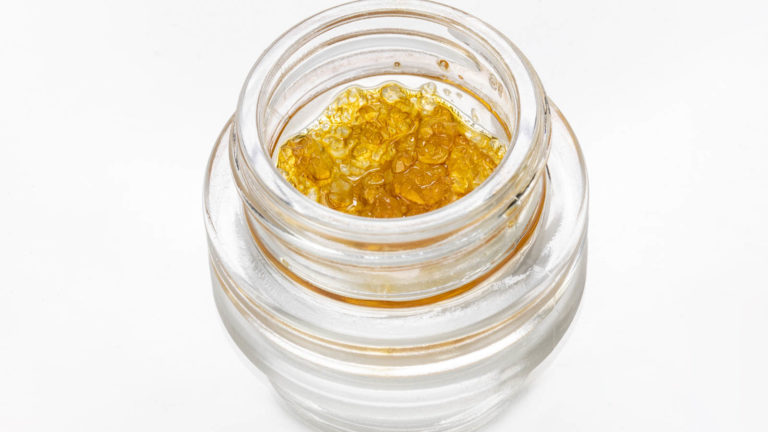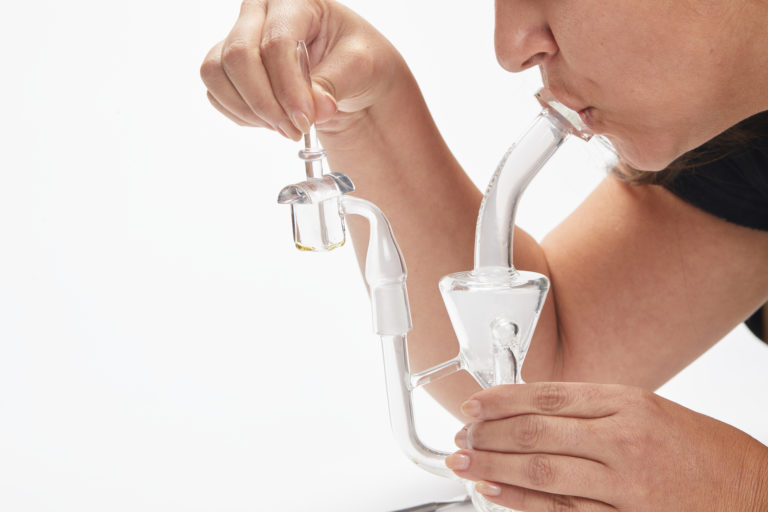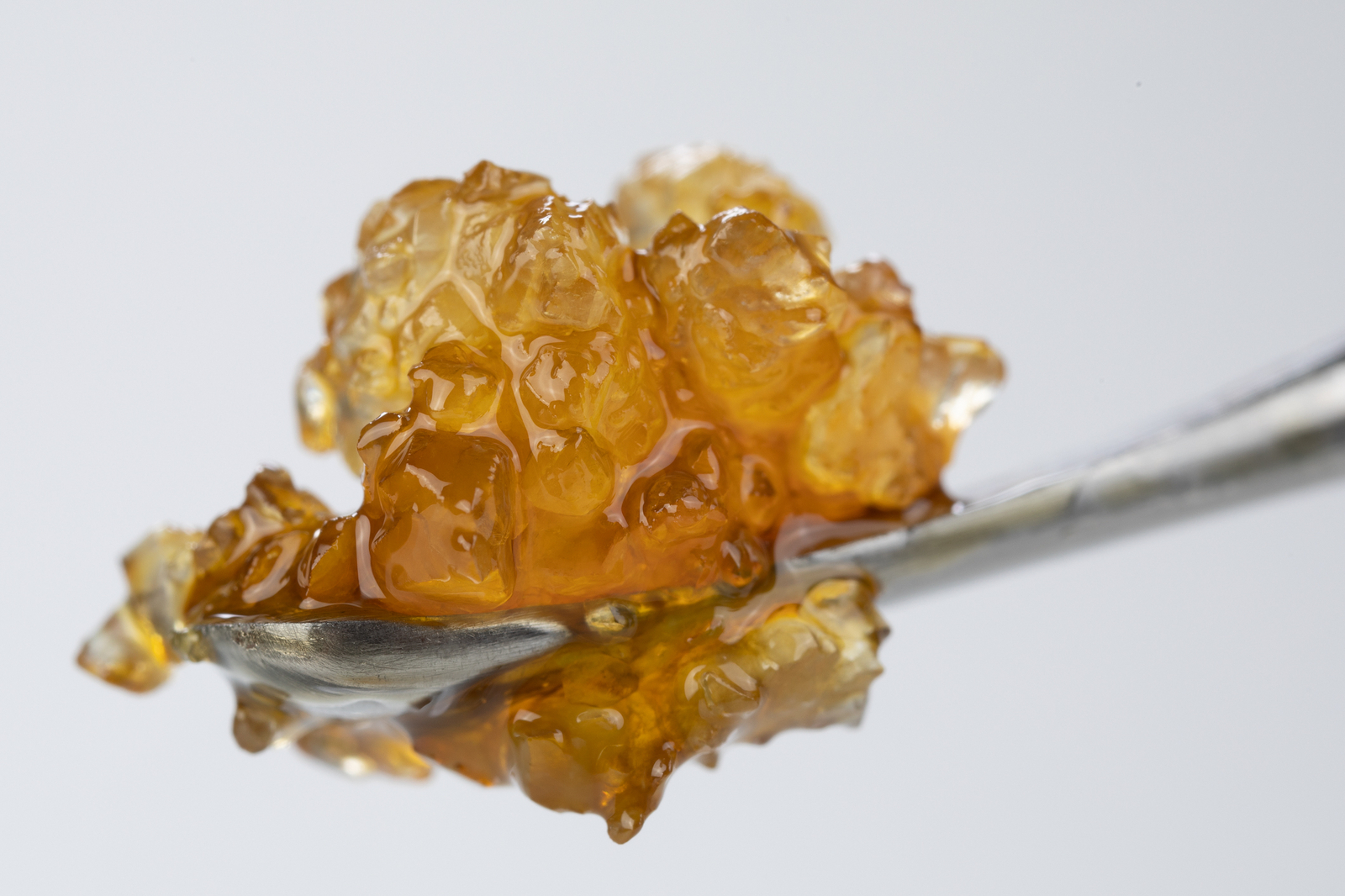Concentrates are what happen when all the goodies from hemp and cannabis plants are extracted. These concentrates are used to infuse all your favorite non-flower CBD products from gummies and facial serums to vapes and tinctures.
That's the short answer and the most technical and literal definition of a CBD concentrate. But when you hear folks refer to “concentrates” in everyday conversation, they are usually talking about a category of super-potent products that include things like shatter, wax, budder, and crumble.
What are CBD concentrates?
Like cannabis concentrates, which are known for potent levels of THC, CBD concentrates offer up very high amounts of their namesake cannabinoid and come in a variety of textures and consistencies. CBD concentrates will have a total CBD content that is higher than almost any other product you'll find on the market.
 Photo by: Gina Coleman/Weedmaps
Photo by: Gina Coleman/WeedmapsImage lightbox

Depending on how the concentrate is made, the CBD may have been stripped down to its essence (as with a CBD isolate), or the concentrate might contain terpenes that were naturally present in the plant. Full-spectrum concentrates contain all the major and minor cannabinoids present in the source plant, while broad-spectrum concentrates are stripped of THC only. There are also concentrates that have very high levels of terpenes, like terp sauce and high-terpene full-spectrum extract.
Concentrates are simple products in terms of ingredients since they generally contain cannabinoids and terpenes and not much else. When extracted and refined with care by experts, they are stripped of unwanted plant materials, waxes, and lipids, leaving behind a pure and minimal final product.
Bottom line: CBD concentrates are highly potent and condensed forms of cannabis. For more on the different types of concentrates out there generally, check out Weedmaps Guide to Concentrates.
How will CBD concentrates make me feel?
Unlike cannabis concentrates, CBD concentrates will not have the same effects on the body and mind that accompany THC. One common misconception around CBD is that it is not psychoactive. Psychoactive means having an effect on the mind, and since there are lots of cannabinoid receptors in the brain, CBD definitely has an effect on the mind. So while THC and CBD are both psychoactive, CBD does not produce the strong euphoria or “high” associated with THC.
A few common reasons that people seek out CBD is to help manage pain and anxiety or to get better sleep, and you might enjoy these same benefits of CBD concentrates. That said, when consuming a high potency product like CBD concentrates, there might be a more noticeable physical experience than when you take lower-dose CBD gummies or tinctures. High amounts of CBD might make you feel drowsy or give your body a tingling sensation, for example.
Bottom line: As always with weed, the experience can vary widely from person to person. But generally, CBD concentrates are not likely to produce a strong psychoactive effect.
Who should use CBD concentrates?
Concentrates are safe (albeit potent), and can be consumed by anyone who wants a big dose of CBD in a jiffy.
Vaporizing and smoking are the two most common ways to consume concentrates. Through the act of inhalation, your bloodstream absorbs CBD much faster than it would after eating an edible or using a tincture under your tongue. Your body will also have access to a lot more of the CBD in the concentrate when it's inhaled. When consumed, a CBD edible goes through your digestive tract and some of the potency is lost in the process of digestion. That's bioavailability in a nutshell.
This means concentrates are a great option for anyone who uses CBD medicinally because they can provide a fast onset and large doses. They can be especially useful for an unexpected flare-up of symptoms that need immediate relief. Because managing disease, illness, or other severe symptoms often requires large amounts of cannabinoids like CBD, concentrates are also a cost-effective and efficient means of getting the high doses you might need.
Outside of medicinal use, concentrates are one of the most popular ways to enjoy cannabis among enthusiasts today. Because many concentrates have robust terpene profiles, they can provide a very unique and enjoyable flavor and aroma experience.
Since by their nature concentrates deliver high amounts of CBD, they might not be right for people who haven't consumed cannabinoids before, or for people who know they are particularly sensitive to the effects of CBD.
Bottom line: High bioavailability and potency make CBD concentrates an excellent choice for medicinal and experienced cannabis users. That said, CBD might interact with prescription medications, so talk to your doctor and do your homework before adding CBD to the mix.
How to use CBD concentrates
Concentrates can range anywhere from 40-99% potency, meaning that they are chock full of CBD. Concentrates are roughly three to five times more potent than the average CBD-rich flower equivalent.
If you do some quick math, one gram of crumble that is 80% CBD will contain 800mg. Since one gram is a relatively small amount, you can see that you might want only a tiny serving to begin with. When in doubt, you can always use an electronic scale to weigh out the exact dose you want.
You can use concentrates in any number of ways. While the most common way to consume them is through inhalation, you could also melt concentrates and use them to infuse your own homemade oils, creams, or balms. Another approach might be to pair concentrates with other products like gummies or topicals to diversify how you consume CBD.
Here's a breakdown of the primary ways to consume and apply CBD concentrates:
Dabbing
Dabbing is the process of inhaling vaporized concentrates with specialized equipment like a dab rig. You might also hear people refer to the concentrates themselves as dabs. And while traditional glass dab rigs were the OG way of dabbing, today there are lots of electronic (like e-rigs) and portable options (like nectar collectors) on the market.
 Photo by: Gina Coleman/Weedmaps
Photo by: Gina Coleman/WeedmapsImage lightbox

Dabbing is done by heating a surface, typically a nail, to high temperatures. Applying the concentrate to the hot surface will cause it to vaporize.
If you are new to cannabis, hemp, and/or cannabinoids, the old sage advice applies doubly with concentrates: start low and go slow. CBD dabs can hit hard and fast, so err on the side of too little because too much of even a good thing can be unpleasant.
For more information on dabbing devices, different types of dabs, and how to dab, check out the Weedmaps' Guide to Dabbing.
Vaporization
You can also use a handheld electronic vaporizer for concentrates. There are lots of models out there that will vaporize both concentrates and flower, which makes these fun pieces of tech doubly useful.
 Photo by: Gina Coleman/Weedmaps
Photo by: Gina Coleman/WeedmapsImage lightbox

Handheld vaporizers also allow for a range of temperatures that can be adjusted with precision. Vaporizers are generally used at lower temperatures than dab and e-rigs, which can preserve some of the other cannabinoids and terpenes that get broken down at high temperatures. They're also more discreet than portable rigs.
Smoking
Concentrates can also be added to flower that you smoke or vaporize. Crumble, for example, can be easily broken up and sprinkled into a joint or added to a bowl because of its fine and crumbly texture. Others like budder, shatter, or crystals might be easier to consume by dabbing or vaporizing.
 Photo by: Gina Coleman/Weedmaps
Photo by: Gina Coleman/WeedmapsImage lightbox

Infusions using concentrates
You can melt concentrates into a carrier oil or butter, then use the infusions to make your own tinctures, edibles, creams or balms.
 Photo by: Gina Coleman/Weedmaps
Photo by: Gina Coleman/WeedmapsImage lightbox

Bottom line: Different consumption methods offer their own unique advantages. Thoughtful trial and error is the best way to find what works for you.
How long do the effects of concentrates last?
If you inhale a concentrate by dabbing or vaporizing, you can expect the effects to last anywhere from two to four hours.
If you've used a concentrate to infuse butter or oil for edibles, the effects can last anywhere from eight to twelve hours. Slipping an infused oil under the tongue allows the membrane in your mouth to absorb the CBD, and these effects last up to four hours. A concentrate that's been added to a topical cream or balm won't get into your bloodstream, and you may notice effects of a topical last for a couple of hours.
Bottom line: The duration of effects depends entirely on the type of product you're using.
How to shop for CBD concentrates
When looking for a concentrate, you will see off the top that they are categorized by how they look and feel. Names like shatter, budder, crumble, sugar, sauce, and crystal will give you a good idea as to the appearance, texture, and consistency of each. Each type will also have its own advantages and disadvantages when handling and consuming, and it might take some experimentation to see which you like best.
You'll also notice that because of their potency, concentrates are sold in small quantities, typically in one gram jars. Don't be alarmed by double-digit prices for these tiny quantities of cannabis. A little bit goes a long way and the price most often reflects the potency.
When shopping for concentrates — CBD or otherwise — look for quality and safety. Hemp and cannabis plant material needs to go through an involved and multi-step process to arrive at a final concentrate, and how well this process is carried out can impact the quality and safety of the final product as can the quality of the plants used and how they were grown.
The best way to ensure the quality and safety of any concentrate is to check out the Certificate of Analysis (COA). These third-party independent tests will show you whether the concentrate contains things like residuals of the solvents used during extraction, pesticides that might have been used on the plant, or heavy metals that might have been in the soil the plants were grown in.
Bottom line: If a retailer or brand can't provide independent lab test results for the product you're interested in, walk away and continue your search elsewhere.

